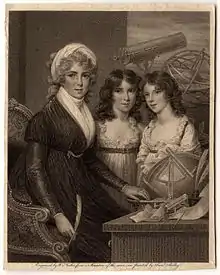Margaret Bryan | |
|---|---|
 Engraving of Bryan and her two daughters Ann Marian (center) and Maria (right) | |
| Born | 12 October 1759 (baptism date) West Ham, Essex |
| Died | possibly 30 March 1836 possibly Fortess Terrace, Kentish Town, London |
| Burial place | possibly St Luke’s Church, Chelsea, London |
| Nationality | English |
| Occupation(s) | Natural philosopher and educator |
| Years active | 1791–1816 |
Margaret Bryan (1759-1836(?)) was an English natural philosopher and educator, and the author of standard scientific textbooks. She was schoolmistress of a school located at various times in Blackheath, at Cadogan Place, and in Margate at Bryan House above the yet to be discovered Margate Caves. Her first known work was Compendious System of Astronomy (1797), collecting her lectures on astronomy. She later published Lectures on Natural Philosophy (1806), a textbook on the fundamentals of physics and astronomy, and an Astronomical and Geographical Class Book for Schools, a thin octavo, in 1815.
Life
Personal information about Margaret Bryan was unknown until genealogical research published in 2023 uncovered many details about her life and family.[1] Baptized on 12 October 1759 in West Ham, Essex, Margaret was the daughter of textile merchant Oswald Haverkam and Sarah (née Wall), whose father was an apothecary. Margaret’s mother, Sarah, died in 1767, and Margaret and her siblings were put under the care of her uncle Thomas Nottidge and a second guardian; her father, Oswald, remarried in 1769 and died in 1781. Margaret, then living in Chigwell, married William Bryan in London on 12 July 1783, had two children, Ann Marian and Maria, in about 1784 and 1786, respectively, and by 1794 she was a widow living in Margate. From about 1791 until about 1816 she operated a boarding school for young ladies, initially in Margate and later in several places in London; during this time she also wrote the books for which she is best known. Sometime during or before 1837 Margaret and her older daughter, Ann Marian, had died; her younger daughter, Maria, lived at least until 1847, at which time she was still unmarried. It is possible, though not certain, that Margaret Bryan died on 30 March 1836 in Kentish Town in north London.
Teaching
Bryan was a schoolmistress. She taught young ladies from at least 1791 until 1797 outside of London, most often at Bryan House on Hooper Hill in Margate.[1] There is evidence to suggest that in July 1794 Bryan’s day school and boarding school were located in Tonbridge and Hadlow in Kent (villages over 60 km away from both Margate and London); the subjects taught included ‘English and French, Music, Writing, Dancing and Drawing, with every kind of Needle and Fancy Work’. Bryan’s school was back in Margate by 1795. From 1798 until at least 1807 the school was located in another Bryan House, this one in Blackheath next to Greenwich Park in London (very near the Royal Observatory). From 1808 or 1809 the school was located at 1 Gloucester Place, Portman Square, and ultimately at 27 Lower Cadogan Place in the Chelsea district of southwest London.
Publications
Bryan's published works are dated 1797 to 1815.[2]
In 1797 Bryan published in quarto, by subscription, a Compendious System of Astronomy, with a portrait of herself and two daughters as a frontispiece, the whole engraved by William Nutter from a miniature by Samuel Shelley. She dedicated her book to her pupils. The lectures of which the book consisted had been praised by Charles Hutton, then at Royal Military Academy, Woolwich.[3] An octavo edition of the work was issued later. The Critical Review printed her reply to what she saw as a damaging article in that journal.[2]
In 1806 Bryan published, also by subscription, and in quarto, Lectures on Natural Philosophy (thirteen lectures on hydrostatics, optics, pneumatics, and acoustics), with a portrait of the author, engraved by Heath, after a painting by T. Kearsley; and there is a notice in it that "Mrs. Bryan educates young ladies at Blackheath." In 1815 Bryan produced an Astronomical and Geographical Class Book for Schools, a thin octavo. The lectures had been previously available only to noblemen, educators, and booksellers.[4] The text was supplemented with diagrams as well as portions for exercises. She described the mechanics of the air rifle, the hot air balloon, the diving bell, as well as works of Isaac Newton, Galileo, and Benjamin Franklin, including the latter's experiments with lightning.
Conversations on Chemistry, published anonymously in 1806, is also ascribed to her by Watt[5] and in the Biographical Dictionary of Living Authors (1816),[6] but is in fact a book by Jane Marcet.
See also
References
- 1 2 Girolami, Gregory S. "Margaret Bryan: Newly Discovered Biographical Information about the Author of A Compendious System of Astronomy," Notes Rec. Roy. Soc. 2023, doi:10.1098/rsnr.2022.0052
- 1 2 Brown, Susan; Patricia Clements; Isobel Grundy. "Margaret Bryan". Orlando Project. Cambridge. Retrieved 23 December 2010.
- ↑ Preface, p. xi
- ↑ "Margaret Bryan: A Scientist Ahead of Her Time".
- ↑ Watt, Robert, Bibliotheca Britannica, Archibald Constable, Edinburgh, 1824, vol. 1, p. 164ff.
- ↑ Anon., A biographical dictionary of the living authors of Great Britain and Ireland, Henry Colburn, London, 1816, p. 43.
- Attribution
- Humphreys, Jennett (1885–1900). . Dictionary of National Biography. London: Smith, Elder & Co.